The pulse of modern urban India, the shifting character of a traditional society caught up in a whirlwind of economic and technological advances are stunningly reflected in an exhibition of contemporary Indian art, newly opened at Tel Aviv Museum.
For this show, curators Tami Katz-Frieman and Rotem Ruff have brought together from one to three works by 17 artists who reside in the major city centers of Mumbai, Delhi or Bangalor. Some of them like Subodh Gupta, Bharti Kher and the Raqs Media Collective are known internationally. The result: a tantalizing variety of paintings, sculpture, photographs, video and installations that jostle for attention.
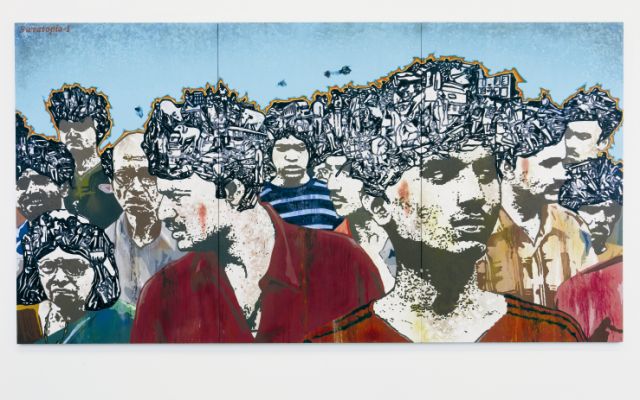
Sights and sounds of the city. Can these be conveyed by a picture? Apparently yes. Sited at the entrance to the exhibition is Sweatopia I (2008), a huge canvas painted by multi-media artist Jitish Kallat, its blotchy appearance suggesting a billboard poster over-exposed to the elements. In this scene, the noises, confusion and chaos of life in an overpopulated city have literally have gone to people’s heads; their hair overrun with human figures, animals, vehicles and the outline of countless passersby.
The inspiration for Annexation (2009), another distinctive work by Kallat, was a Victorian Gothic style frieze at Mumbai’s Chhatrapati Shivaji Terminus, previously known as the Victoria station. His construction, in steel and painted black lead, is in the form of an outsize acetylene burner of the type used by people cooking on the streets. It is heavily ornamented with the intertwined forms of birds, fishes and beasts fighting for survival, just as, in real time, the mass of humanity on the city streets is battling to sustain itself.
The cries of hawkers offering their wares have become the subject of a poetic video and sound installation by Rashmi Kaleka. The voices of 20 hawkers are heard, distilled from recordings and films made by Kaleka over a five year period, of two thousand different voices. Neither the street nor the hawkers are shown; instead, the rising and falling sounds are heard against a backdrop of the rooftops of Delhi bathed in an early morning light.

Giga Scaria’s Elevator from the Sub-Continent (2011) shown last year at the 54th Venice Biennale, offers another view of urban life. Entering what appears to be a regular elevator, one finds when the doors close that there is only an illusion of movement. Scenic projections on three walls produce the effect that the spectator is descending and ascending through different levels of a building, glimpsing the interior of homes of people from very diverse social classes. (Warning! If you suffer from claustrophobia/vertigo give this one a miss.).
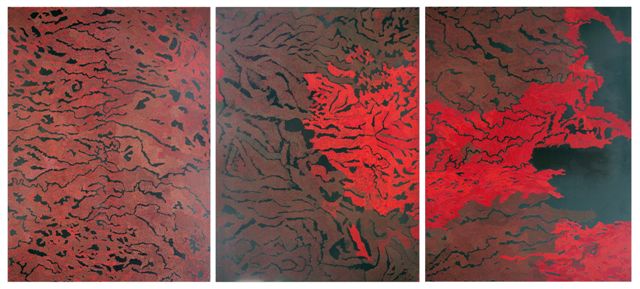
The adaptation of traditional crafts or imagery. Making a vivid impression is a monumental triptych by Bharti Kher who has adopted the bindi as her artistic trademark. This is the sign of a married woman, but it is also traditionally conceived in India as the third eye linking the material with the spiritual world. Employing hundreds of these small, vividly colored ornaments, Kher paints flowing abstract patterns as in Drunken Frenzy of Love (2010) where cell-like shapes appear to be moving across her board, enveloping each other. This imagery might be viewed as a metaphor for the large-scale migration that takes place within India itself, from rural areas to the cities.
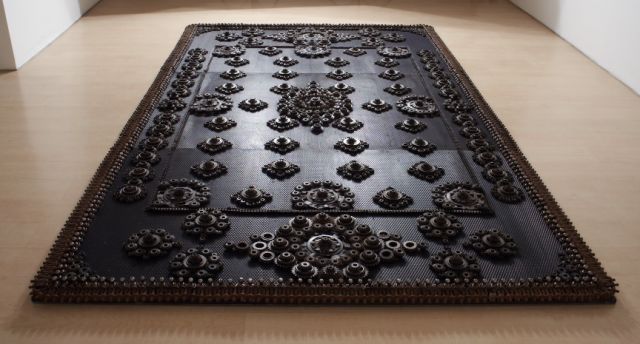
And then there is Freedom is Everything (2007), Sakshi Gupta‘s regal carpet. But come close, or step on it, and one finds that it is actually constructed from small auto parts, wheels and bolts arranged in an intricate pattern. Gupta also utilizes metal scraps for a second exhibit: a rooster hanging upside down from the ceiling. We don’t know why the artist chose this particular animal for her work; or why it is hung upside down. The answer may lie in the artist desire to question the Indian myth that the rooster “heralds the dawn of wisdom and the conquest of the forces of ignorance.”
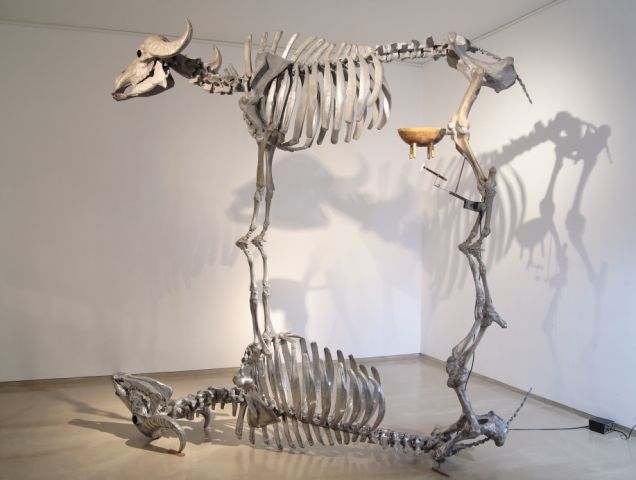
The debasing of icons. Two works by Sudarshan Shetty effectively illustrate this characteristic. The first icon is the Taj Mahal, jewel of Muslim art and world famous symbol of eternal love. Assembling hundreds of aluminum replicas of this historic monument like those sold to tourists, he bolts them together to form a 4 meter wall, rendering the idea of this historic building absolutely meaningless.
The second icon that Shetty deals with is the cow, a sacred animal in India. For Untitled (Double Cow, from the exhibition Love 2006) a mechanical sculptural installation, he turns two animals into skeletons, their hooves place on top of one another as if frozen in a sexual act. At intervals a hammer strikes at the metal udder of the uppermost animals producing a sound like a temple bell. The resultant effect: an amusing, ridiculous object.
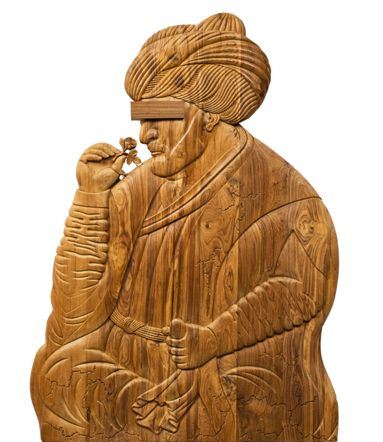
War and conflict. Drawing inspiration from the ancient crafts of metalworking and wood carving Riyas Komu offers two intriguing pieces that relate to the never-ending cycle of combat and violence. Blood Brothers (2010), an aluminum relief more than 7 meters long, is made up of the identical figures of 360 warriors arranged in registers in fighting pairs, wearing helmets, armor and brandishing swords. The piece, vaguely recalling an archaic memorial, is dimly lit, and this feature adds to its somber and timeless mood.
For Fragrance of Funeral II (2011) Komu has carved a majestic figure in wood, an image taken from medieval sources. The man’s eyes are masked and he holds a flower to his nose in one hand, the other grasps a handkerchief. A real feeling of sadness emanates from this image which according to the artist “embodies the memory of both death and life, a metaphor for that elusive essence that survives the carnage of war and witnesses the eternal repetition of the same mistakes from which nothing is learnt.”
Also participating are Shilpa Gupta, Ravi Agarwal, Atul Bhalla, Ranbir Kaleka, Shanthamani M, T.V. Santhosh, L.N.Tallur and Lochan Upadhyay
Critical Mass: Contemporary Art from India – Herta and Paul Amir Building, Tel Aviv Museum of Art
Open till December 16th 2012






I found this a most interesting and stimulating article.
Comments are closed.